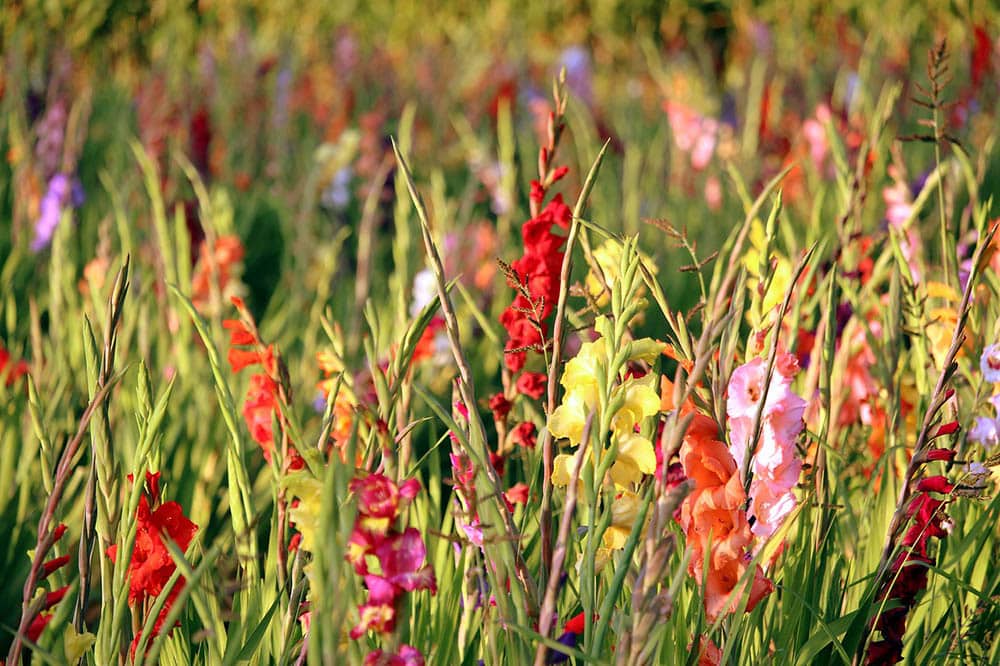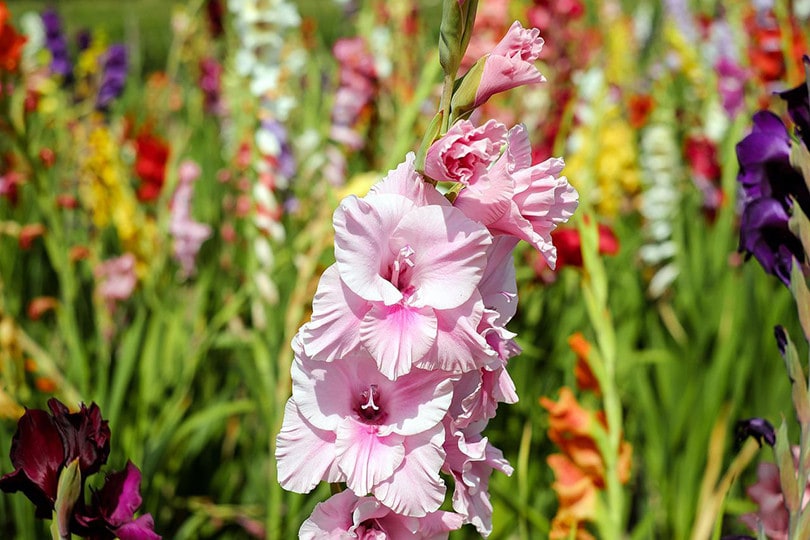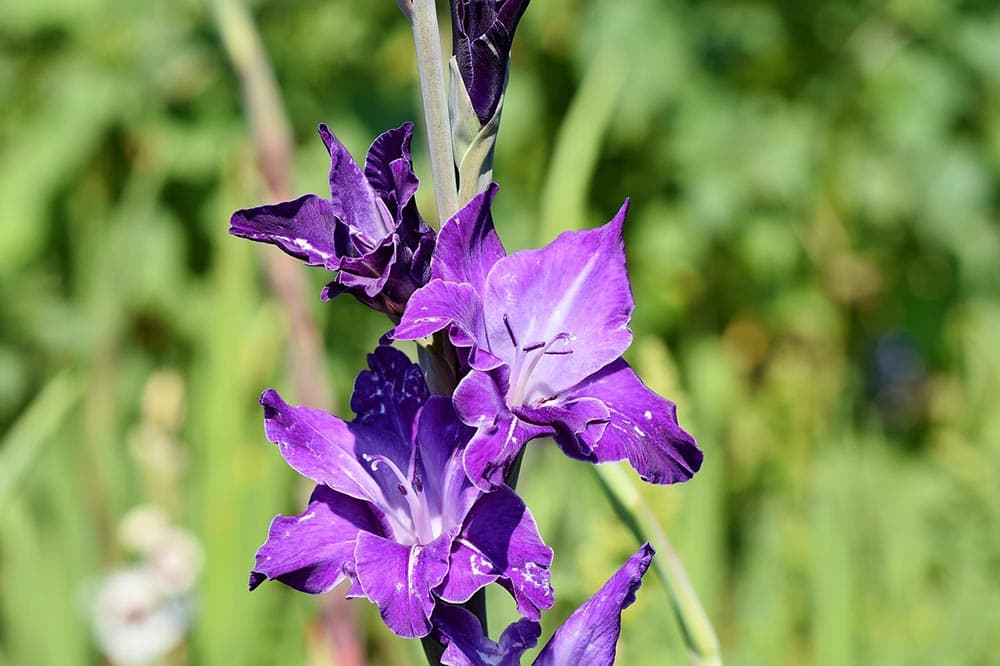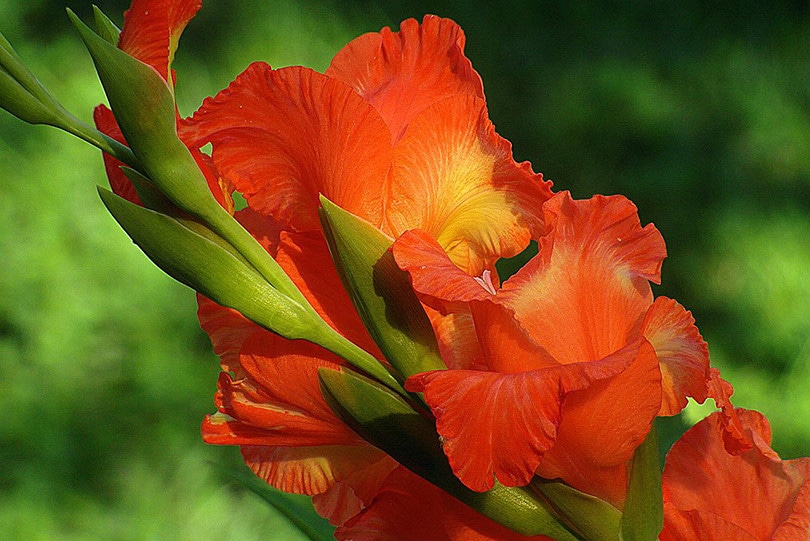When Do Gladiolus Bloom? Care, Factors & Planting Tips
-

- Last updated:

When gladiolus flowers bloom, they become the queens of the gardens and landscapes, adorning their tall, bright, and trumpet-shaped petals that grow off sword-like stems. After sowing, which is often done in spring when frost season has passed, gladiolus plants take about 3 months to mature. This means you’ll notice the flowers starting to form in the late fall or early summer.
Perhaps you planted them in your garden and are wondering when the blooming season will begin. If that’s the case, we have you covered. This article addresses everything you need to know about the blooming of gladiolus plants and what to do if they fail to bloom.

How to Grow Gladioli in Your Garden
Gladiolus is a perennial plant that grows from underground storage organs that closely resemble onion bulbs, known as corms. The Missouri Botanical Garden reports that they do well in USDA hardiness zones 7 to 10 and full sunshine exposure.
Depending on the size of the corms, the gladioli plants are planted between 4–6 inches deep and grow as tall as 6 feet high and 1 foot wide. Expect them to become taller, stronger, and more attractive if the soil is well-draining and contains plenty of organic matter.
- Dig the planting area early enough and improve the soil moisture by adding well-rotten compost.
- Plant your gladioli in early May near a fence or wall that receives sufficient sunlight. Being relatively tall, they’ll require the fence structure for support.
- Set up soft bamboo stakes at the end of each row and use a string line to connect them when planting. This will also aid in support since gladioli flowers and flower buds can become top-heavy and threaten the plants to fall.
- Ensure you water your plants up to 1 inch for the first two weeks. After that, watering once in a while is advised, but ensure the plants remain healthy.
- Add a fertilizer when the buds start to form. You can always know that fertilization is due if you can feel a bulge at the base of the gladioli leaves. The bulging tells if the buds have formed.

Where to Plant Gladiolus
Gladiolus doesn’t need much room to grow. For that reason, they could be planted in flower gardens, vegetable gardens, patios, containers, and flower beds.
Cut Flower Gardens
In a 2’ x 4’ space, you can grow as many as 50 gladioli corms without overpopulating the garden. You’ll only need to cut the stems when the two flowers are fully blooming. As a result, the flowers will last for at least 2 weeks, and you’ll only pull the bottom ones as they fade.
Containers
When they are planted with other bold topicals such as coleus, cannas, and elephant ears, gladiolus blooms create a wonderful sight to behold. You can also plant them singly in containers and they’ll still look attractive.
Flower Beds
If you want your flower bed to stand out in the summer, you should plant gladiolus. This is because they bloom in late summer when most types of flowers are beginning to die. With their tall spikes that overlook other plants, they add both color and attraction to your flower bed.
Vegetable Gardens
When you harvest vegetable crops such as lettuce, spinach, and peas in early summer, you can replace the empty spaces with gladiolus corms. Consequently, the glad flowers will be available for adorning your dining room table from late summer to early fall.

When Do the Flowers Bloom?
As mentioned earlier, gladioli are often sowed in spring and take about three months to mature, after which you’ll notice them starting to bloom in the late fall or early summer. The blooming season lasts ten weeks.
One corm produces a flower spike that measures about 3–4 feet and has up to 20 fist-sized florets. They open one after another starting from the bottom, meaning each flower from the stems may blossom for two weeks.
Their sepals and petals look almost identical and are united at their base into a tube-like structure. They come in a wide range of colors – red, pink, purple, white, orange, and even green.
How Do You Keep Gladiolus Blooming?
The blooming season will begin after 10–12 weeks and will last for another 3 months. But since you don’t want the blooming season to last very shortly, here’s what you should do: Instead of planting all your corms at once, plant only a handful every 2 weeks from spring to early summer (March to May). By doing this, all your gladioli will not reach maturity at once but will bloom successively from late summer to late fall.
Alternatively, you can extend the flowering season by planting different gladiolus in your garden. While the gladiolus genus includes over 300 species of flower colors, you should consider planting peacock orchids (Gladiolus muriale) with the full-size hybrids and the harder dwarf (Gladiolus nanas) plants.

How to Care for Gladiolus After They Bloom
If you live in a hardiness zone 7–10, you may leave the corms in the field because gladiolus bulbs are winter-hardy in such areas. However, they must be dug out in colder zones and stored to be replanted the following season. It is better to treat gladiolus like an annual plant by pulling them out when the blooming season ends and planting fresh corms the following spring.
- Cut off the flower stalks when the blooming season is over but let the shoots keep growing.
- After the first frost, dig out the entire plant using a spade or garden fork without detaching the foliage from the corm.
- Allow the plants to dry for a couple of weeks. Keep them in a well-ventilated area.
- Once the foliage shrivels and the stems begin to dry, cut off the corms using a knife. Ensure at least an inch of the stem is attached to the corms.
- Rub off the little round “cormels” clinging to the newly-dug corms using your thumb. Although you can grow these miniature corms, you’d better not because they will not only take years before blooming but will also give birth to dwarf gladiolus plants.
- Store the corms in a dry peat moss or mesh bag until the winter season is over. The storage area should be cool but not freezing (40°F)–50°F).
Reasons Why Your Gladiolus Did Not Flower
If you planted gladioli in the garden and they sprouted so well but failed to flower 3 months later, the following explanations might carry the reason:
Site Conditions
It’s possible that your gladioli did not flower because of the site conditions. Perhaps the corms froze because they were stored in a cold place or maybe there were floods. When they freeze, the corms often crack and get mushy, eventually molding and rotting.
Your gladioli may not flower as well if they are planted in overshaded ground. Tall trees may prevent sunlight, which is a critical aspect of the growth of gladiolus plants.
In addition, if the soils are too compacted, the thin stems and leaves may find it difficult to push through. To minimize this hindrance, it’s advisable to lift the soil each year by re-cultivating the flower beds/gardens.

Age
Over time, gladiolus corms increase in size, but the original corms finally become spent. The time it takes before this happens may vary but the new corms will eventually slack.
Fertilizer
If you planted too small corms, they may not bloom in the first year because their systems aren’t fully developed. In the spring of the following year, boost them with a balanced 8-8-8 fertilizer to encourage the formation of both foliage and bloom.
High nitrogen levels may hinder the growth and flowering of gladiolus plants, so, avoid plant foods that have high percentages of it. Also, do not grow them near the lawn as they may get exposed to the high nitrogen content of lawn fertilizers.
Pests
Thrips are tiny pests that often attack gladiolus. Once they infest your garden, it is almost guaranteed that your gladiolus will not bloom because they cause withering and falling off of the forming blooms before they are fully formed.
Other pests that affect the blooming of gladioli include squirrels, moles, and field mice. They munch the corms, eventually hindering blooming.
Disease
Corms are also susceptible to diseases. Some of the common diseases in gladioli are root blights, bacterial scabs, and a range of other viruses. Rot is also another common disease that highly contributes to no blooms.
To minimize disease infestation in gladiolus, it’s essential to store the corms in a cool and dry place and to select only the healthy and unblemished ones during planting.
In Conclusion
Without a doubt, gladiolus plants make all landscapes more graceful and every table vase full. If you planted them correctly during the spring season, you can expect them to bloom all through late summer and early fall.
It is evident that to grow high-quality gladioli, you must take care of the corms from the end of the blooming season. You have to harvest them cautiously, store them safely, plant them accordingly, and maintain them routinely and properly.
- Gladiolus (Aunt Eliza Rat’s Rail, Gladiola, Gladiolus, Glads, Sword Lilies, Sword Lily) | North Carolina Extension Gardener Plant Toolbox
- How To Grow Gladiolus | American Meadows
- Gladiolus (group) – Plant Finder
- When do gladiolus bloom? And what to do to for show-stopping flowers |
- When Do Gladiolus Flowers Bloom? | Hunker
- Does Gladiolus Flower More Than Once Per Season?
- How to Plant, Grow, and Care for Gladiolus Flowers | The Old Farmer’s Almanac
- All About Gladiolus
Featured Image Credit: Melanie, Pixabay
Contents

